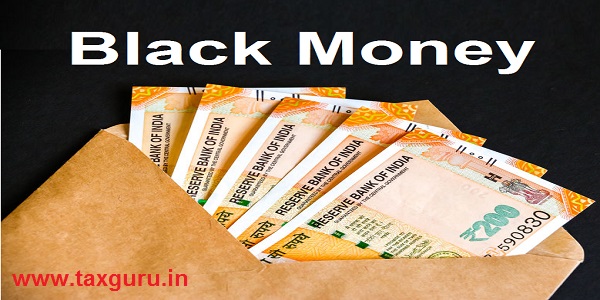
Black Money – A Parallel Economy
“Black Money to our white economy is like a tumour in the centre of the brain”
or
Ads by
“What tumour is to the brain is exactly what black money is to our white economy”
Having said that, black money is a major challenge for any economy, where high net worth persons, disproportionate their assets to save themselves from the high taxation system. But what is exactly black money, how it is generated and why government find it difficult to catch such arrangements? Let’s dive deeper into such issues and see for ourselves.
Content: –
1. What is black money?
2. What is Parallel economy & why does it exist?
3. What is Money Laundering?
4. Steps taken by the government to tackle black money and money laundering.
What is Black Money?
There is no as such uniform or accepted definition of ‘black’ money. It can be best understood as any money that breaks laws in its origin, movement or use, and is not reported for tax purposes, then such money would fall within the meaning of black money.
In other words, any money to be classified as Black money must fall under either of the two categories: –
I. First, any money earned through any activity defined as illegal by virtue of any law prevailing in the country.
II. The second category comprises of the generation of income from a legal activity that is not reported to the tax authorities and any audit trail relating thereto has been removed, leading to evasion of one or more taxes.
Here are different situations where money generated can be said to be black money:
Situation 1) – Any money generated by the way of bribery, racketeering, trafficking in counterfeit forgery, securities fraud and embezzlement will be classified as black money as per category (i).
Situation 2) – Mr. Y agrees to sale a land for Rs. 1,00,00,00/- to Mr. X. The payment terms for this transaction was agreed as 60% by bank transfer and 40% in cash, however, the sale deed recognizes only Rs. 60,00,000/- as sale consideration (60% of decided amount) without mentioning any cash transaction. Therefore, the remaining 40% constitutes as black money component passing from Mr X to Mr. Y without reporting it to taxation authorities and for the eyes of law, making it seems like that this sale transaction has taken place at Rs. 60,00,000/- only that too through proper banking channels. Hence, Rs. 40,00,000/- will be classified as Black money as per category (ii). (Reference to this situation is made several times throughout this article).
To summarize, Black money proceeds are usually received in cash from underground/parallel economic activity and, as such, are not taxed. Recipients of black money usually hide it, spend it only in the underground/parallel economy, or attempt to give it the appearance of legitimacy through money laundering.
Also, several terms are used to describe Black Money – ‘black income’, ‘dirty money’, ‘black wealth’, ‘underground wealth’, ‘black economy’, ‘parallel economy’, ‘shadow economy’, ‘underground’ or ‘unofficial’ economy.
What is Parallel economy & why does it exist?
The black money/unaccounted money cannot be transacted in the normal economy as it will catch the government’s eye and tax authorities would figure out the generation of such black money. Therefore, to avoid that, a parallel economy exists.
The word “parallel” means the occurrence of something in a similar fashion or at the same time.
The “economy” of the country constitutes people buying, selling, and creating goods and services. These financial transactions are meant to help common people and the country.
Now, if we do the same thing: buy, sell and create ( an economic system) but with black money and without involving government or without government’s knowledge which basically means we are creating an analogous or similar system which operates in PARALLEL to government system without giving the country and people it’s due share, further, these transactions do not get compiled with the national income data. Thus, it is called the parallel economy.
If we look back to the situation (ii) described above, the land was officially sold at Rs. 60,00,000/- as per the sale deed and in the eyes of law (all taxes and Capital gains will be charged on Rs. 60,00,000/-) but parallelly for the same transaction additional Rs. 40,00,000/- was also given (hidden from the government), thus, Rs. 60,00,000/- becomes part of the white economy and Rs. 40,00,000 does not even exist in legal terms. Now for Mr. Y to use this non-existing sum of Rs. 40,00,000/- he must do transaction hiding it from the government. With this, a cycle continues of passing this money from one person to another, giving rise to a parallel economy. Thus, this is how the parallel economy exists and operates.
After understanding all this, here a question arises, why the parallel economy is tumour to the white economy? To briefly touch on this, it can be best understood by following impact which parallel economy can have on white economy: –
1. Under-estimation of the true size of the economy,
2. Tax evasion, thereby loss of revenue to Government,
3. Undermining equity,
4. Widening Gap between the Rich and Poor,
5. Lavish Consumption Spending,
6. Effects on Production.
What is Money Laundering?
Now, we know how black money is generated and used for a transaction, but what if a person wants to use this money for expenditure into the white economy as legitimate money, then such person needs to convert such money into white money through the process of money laundering.
There are three stages involved in money laundering:
1. Placement – First is injecting the black money into the official financial system.
2. Layering – After placement comes, layering stage. The layering stage is the most complex part of the process. In this the money spreads into various different accounts in different countries and constantly moving it from one account to another or even from country to country, each time exploiting the loopholes in the system. The more level of layering, the detection of the origin of money will be more difficult.
3. Integration – The final stage of the money laundering process is termed the integration stage. It is at the integration stage where the money is returned to the person making it seem like a legitimate source.
A person could formulate ‘N’ number of strategies/arrangements of money laundering. Let’s see the complete scenario where Mr. Y from our situation (ii) above, converts his Rs. 40,00,000/- into legitimate money.
Step 1- Mr. Y contacts a hawaladar, Mr. A, and handover him Rs. 40,00,000/- in cash, thereafter the partner of Mr. A in country XYZ which is a tax haven, splits & deposits the same amount of money after deducting their commission into the bank accounts of 4 different shell/paper dummy companies controlled by them, incorporated outside India. (Placement)
Step 2 – Now, these 4 companies splits & floats this money in multiple bank accounts of 15 different dummy entities in the form of unsecured loan, payments for fake invoices, fake contracts, investments, anonymous donations etc. This is layering; this process could be repeated several times, making layers after layers, making it harder to identify a trail.
Step 3 – The last step is to return this money to the source i.e. to Mr. Y & making it look like legitimate money (integration), to accomplish this, these 15 different entities therein transfer this money as an investment in the share capital of M/s Y Ltd, an Indian Company, where Mr. Y is beneficial owner/director/member/promoter/employee.
Now for the last leg of this arrangement, M/s Y Ltd. transfers part of this money to Mr. Y in the form of high salary and the partial amount by entering into an agreement with Mrs. Y for purchase of property and paying the advance for the same. Later, terminating the agreement over a dispute, leading Mrs. Y to forfeit the advance amount, making it appear like a legitimate transaction between two parties, later Mrs. Y transfers this amount to Mr. Y as a gift.
Steps taken by the government to tackle black money and money laundering.
In the scenario described above, Mr. Y converts his black money into white money without drawing unwanted attention, right? No, that’s not the case, the government is keeping a vigil on our every transaction and zealously pursuing policies to minimize these kinds of arrangements.
Action against black money is an on-going process. Such actions include policy-level initiatives, effective enforcement action on the ground, putting in place robust legislative and administrative frameworks, systems and processes with due focus on capacity building and integration and mining of information. Some of the step government has taken to curb black money and control money laundering are as follows:
1. The Black Money (Undisclosed Foreign Income and Assets) and Imposition of Tax Act, 2015 (“BMA”) Enactment of BMA is to specifically deal with black money stashed abroad.
2. The Benami Transactions (Prohibition) Amendment Act, 2016: the main aim of this act is to striking the benami transactions and inter alia confiscate Benami property and prosecute benamidar and the beneficial owner.
3. Prevention of Money-Laundering Act, 2002 (PMLA): It forms the core of the legal framework put in place by India to combat Money Laundering.
4. Constitution of the Special Investigation Team (SIT)
5. Constitution of Multi-Agency Group
6. Engagement with Foreign Governments. enhancing the exchange of information under Double Tax Avoidance Agreement/Tax Information Exchange Agreements/multilateral conventions.
7. Introducing General Anti- Avoidance Rule (GAAR) to enable authorities to neutralise the tax edge obtained through shell companies/companies in tax havens.
8. Restrictions on Cash transactions.
9. The Smugglers and Foreign Exchange Manipulators (Forfeiture of Property) Act, 1976: It covers penalty of illegally acquired properties of smugglers and foreign exchange manipulators and for matters connected therewith and incidental thereto.
10. Narcotic Drugs and Psychotropic Substances Act, 1985: It provides for the penalty of property derived from/or used in illegal traffic in narcotic drugs.
11. Financial Intelligence Unit-IND: It is an independent body reporting directly to the Economic Intelligence Council (EIC) headed by the Finance Minister.
12. India is a full-fledged member of the Financial Action Task Force (FATF).
Conclusion
On one hand, the creation of black money and the existence of a parallel economy is a challenge which almost every economy is facing, what makes it even more dangerous is the involvement of people in money laundering and giving it a legitimate look. On the other hand, the government has taken various steps to curb out the black money, but still, there is a long way to go to successfully run a crusade against black money, the government requires more reform, reasonable taxes, and wider but simpler regulations to disengage the problem from the source i.e., reduce the incentive to generate black money.







